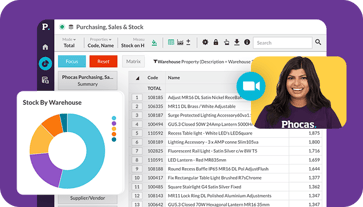Why add external data sources (like HR systems) to your analysis?
When you’re making an important financial decision, you want all the key numbers and metrics at your fingertips. That’s why it’s critical to have an enterprise resource planning (ERP) system that integrates seamlessly with an analytics tool so it can draw in other sources of data from inside and outside your business.
The most successful and forward-thinking organizations tap into all types of data sources to enhance decision-making, address new opportunities, and improve their overall operations. How can adding more data sources to your analysis set help? Let’s take a look.
The benefits of additional sources of data
If you aren’t taking advantage of your ERP’s integrations into other systems such as Salesforce, Hubspot and HR databases, you could miss some valuable insights. Here’s what adding external data sources could do for your team:
- Creates a single source of truth. An integrated data analytics solution automatically collects all of the data in the organization's ERP plus other data sources and consolidates it into one cohesive source of truth. Then everyone can draw from the same set of data to make business decisions.
- Provides more information to base decisions. When you have all of the data in one place, you have a more informed understanding to make decisions.
- Brings clarity to areas of opportunity. With access to external data sources, you increase your understanding of every level of the business. That enables you to pinpoint areas to reduce waste, boost sales opportunities, improve customer profitability, and more.
- Puts the data in a different light. Not every ERP can provide the tools you need to address complex challenges so many businesses add data analytics systems to help them present the data in an easy-to-read, visual format that is easily accessible to everyone in the company. Some solutions get to work immediately after the data integration to produce dashboards, KPIs, data cubes, and reports.
What your human resources data can tell you?
A wellspring of valuable data could be also hiding in your organization’s Human Resources (HR) system — and that could be immensely helpful for future financial decisions.
Now is the time to start building a case for why HR metrics should be tracked just like any other metric in the business — and integrated with your ERP for maximum value.
Some common metrics you can track include revenue per employee, training efficiency, time-to-hire rate, voluntary turnover rate, absenteeism, and training expenses per employee.
Just as data helps inform your key financial decisions, these HR metrics can help your team answer questions about how your employees are performing, where improvements can be made, and what the organization needs to do to meet its goals — such as improving culture, retention, engagement, and recruitment.
When you analyze HR metrics, you’re adding another powerful layer of information to the process to optimize business goals. That could mean finding ways to reduce your hire time, retain top performers, and improve employee morale.
As you add external data sources in your ERP, partner with a vendor that seamlessly integrates all of your important data in one place to facilitate better decision-making. Using a software solution like Phocas offers you a clear, broad view of every department, giving you better insight into how the company performs at all levels.


Empowering businesses with intuitive data analytics, driving informed decisions for growth and profitability. We make people feel good about data.
Related blog posts

How can you maximize the business benefits from your enterprise resource planning (ERP) system? You get there by rethinking ERP reporting as a layered reporting system that turns ERP data into real-time insights, not just historical outputs. For years, enterprise resource planning platforms have been the backbone of manufacturing, distribution and retail because they capture orders, inventory, invoices and financial data in one place. Yet the price and effort of implementing ERP software has often led business people to question whether the company is getting the value they expected. It depends on how well people can access, analyze and act on the information inside the ERP system and related data sources.
Read more
Financial planning and analysis (FP&A) provides the insights that drive growth, protect profitability and guide new investments. Done well, FP&A transforms raw financial data into scenario models and forecasts, helping finance leaders and business units move ahead with confidence.
Read more
Picture a football coach preparing for the big game. He watches game‑tape, studying player metrics, analyzing every play and using real‑time stats to inform strategy. That’s exactly how sales managers and sales leaders should approach their coaching program—with a data‑driven approach.
Read more
“Free BI tools trial, business analytics software for free, free BI reporting with AI-powered insights”– these offers are tempting business people all the time especially as new open-source players enter the market and want cut-through.
Read moreBrowse by category

Find out how our platform gives you the visibility you need to get more done.
Get your demo today